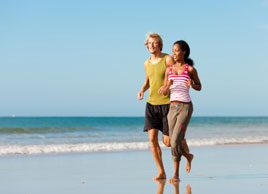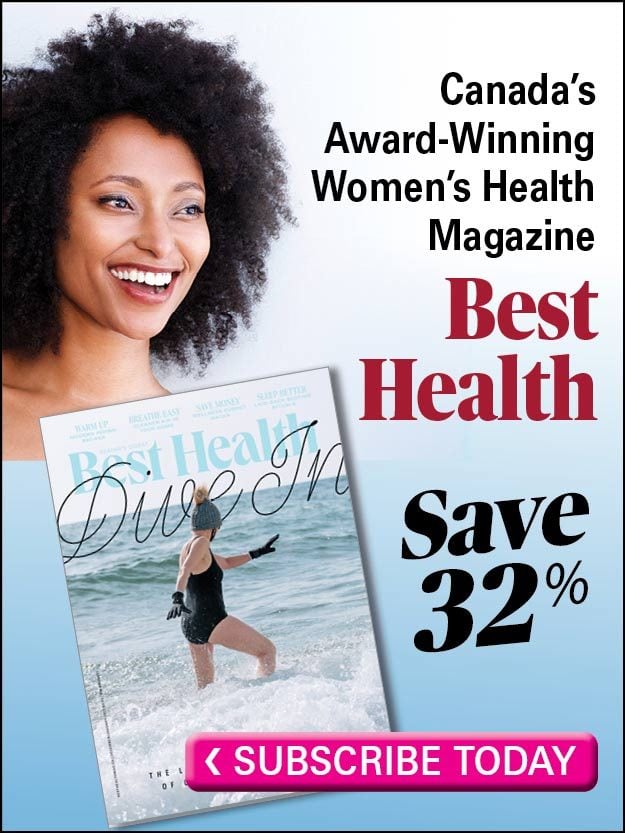Should you try barefoot running?
This fitness trend is picking up in popularity. Find out if barefoot running is right for you

Source: Best Health Magazine, November 2011
It’s November in Vancouver, the temperature is just below zero, and a mixture of snow and sleet blankets the pavement and settles on trees. A group of runners is completing a 10K run on the University of British Columbia’s picturesque campus. One slender figure in the group appears to be skipping lightly across the frozen pavement, with a shorter stride and more upright posture than the others. That’s because she’s not wearing shoes.
With every step she takes on the asphalt, Katie Kift of Port Moody, B.C., feels the slush, the cold and the bumpy surface’and to her, it’s an elixir.
Kift is not alone. She started the first Canadian chapter of the Barefoot Runners Society, and this growing U.S.-based organization now has a second chapter in Toronto. Barefoot running has passionate followers who believe that not wearing shoes for running puts the body into a more natural, safer posture.
Kift, 38, decided to take up running a few years ago when a diagnostic X-ray showing early degenerative changes in her spine prompted her to take action. After being fitted with the proper running shoes, she was enjoying running and had worked up to a 5K when she developed a stress fracture in one heel. Disappointed, Kift consulted the Internet for information on stress fractures, and discovered barefoot running. She began training on an indoor track. When she found out running in bare feet was against the rules, she took to the trails near her home’and she hasn’t looked back.
But what about the pain, or possible injury? Seasoned barefooters say you build thicker skin on your soles. But there’s also the option of ‘minimalist’ shoes, which are flexible and lightweight, with thin soles and less heel height than traditional running shoes. One of the first was the Vibram FiveFingers, introduced in Italy and the U.S. in 2006, but there are many more on the market now.
‘When running barefoot, the foot and ankle play an increased role in impact absorption,’ says Michael Ryan, a scientist at the University of Wisconsin’Madison whose research focuses on sports medicine and orthopedics (and who is a minimalist convert himself). ‘It’s what they’re designed to do. Shoes shelter the foot from stress, and there is a disproportionate load in the knee and hip areas.’
Ryan advises caution when switching to minimalist shoes or going barefoot; the muscles, tendons and bones of the foot need time to adapt to the changes in impact, as does the rest of the body. Ryan, who runs ‘up to 22 kilometres in minimalist shoes on weekends, and eight kilometres twice during the week, says that his body has adapted. ‘I feel more natural; my running is not as much of an effort,’ he says. Although Ryan thinks the trend may be slower to catch on in Canada, ‘it’s not going to go away.’
Vanessa Rodriguez of Toronto began running at age 24 to help her cope with stress, but recently switched to barefoot. ‘I generally run on trails,’ says the 29-year-old online editor and nutritionist. ‘I like the feeling of being barefoot. It’s not just exercise: It’s a mind-body experience.’
Obviously, barefoot runners anywhere east of B.C.’s southwestern coastal area face colder temperatures and more snow when running in the Canadian winter. Though Rodriguez knows runners who will brave temperatures as low as ’15°C, she dons minimalist shoes when the temperature dips below zero, adding socks for warmth and prevention of blisters. These are one of the most common barefoot running injuries, especially during the beginning stages, according to Australia’s Dr. Craig Richards and American Thomas Hollowell, authors of The Complete Idiot’s Guide to Barefoot Running.
What about a more serious injury? ‘I’ve been lucky,’ says Rodriguez. ‘I’ve never stubbed a toe or stepped on anything sharp.’ She says it becomes second nature to scan for danger on the ground ahead. Kift says if she steps on something, her foot is off it in a second, and the object doesn’t break the skin.
Most barefoot runners will agree that running unshod changes almost everything about their running form. Stride is shortened, number of steps per minute increases, posture is more upright, and the foot meets the ground in the forefoot area rather than the heel. What about arch support? The muscles of the arch are strengthened and support the foot better.
Benno Nigg, an expert in the biomechanics of running at the University of Calgary’s Human Performance Lab and the author of Biomechanics of Sport Shoes, agrees with findings that regardless of advances in shoes, injury rates have not changed appreciably over the years. The best shoe for runners is the one that is most comfortable. Nigg says barefoot running isn’t new (think Zola Budd in the 1980s), and he believes the recent trend toward less bulky shoes will last.
If you’re anxious to hit the trails sans shoes, be sure to transition gradually. Always do a pre-run warm-up, and, advise Richards and Hollowell, carry a first-aid kit and steer clear of any rock salt during winter months. In such conditions, wearing at least minimalist shoes is a good idea. Be ready for sore foot muscles that haven’t previously been used, and see a physiotherapist for some specific stretches and exercises to prepare your body. And remember: The die-hards who run in sub-zero temperatures have spent several seasons habituating their feet.
Contends Kift, who recently took the step of learning to swim to prepare for triathlons: ‘Barefoot running has made me bolder.’
This article was originally titled "Footloose" in the November 2011 issue of Best Health. Subscribe today to get the full Best Health experience’and never miss an issue!




